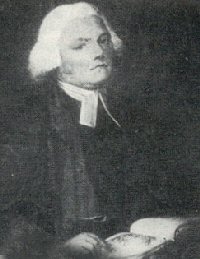The name 'Gilbert 21' is an homage to Gilbert White, the 18th century English naturalist and author
of The Natural History and Antiquities of Selborne. The '21' is, of course, a reference to the 21st century.

Gilbert White was a bit camera shy
(easel shy?). This one is not now
thought to be authentic!
In his day Gilbert White was revolutionary. Although the roots of the study of
natural history reach back beyond Gilbert White, it was he who virtually
single-handedly popularised it as a subject worthy of study in its own right. Any
naturalist who reads the Natural History of Selborne today - over 220 years
after its publication - will recognise White's spirit of enquiry and respect for
the natural world as the very same values that drive us to study natural history
today.
Gilbert White was an ordained
clergyman and, for a great part of his professional life, the curate of Selborne
(the very village where he was born). He was a true 'expert amateur naturalist' and it is probably no coincidence that, to this day, the ephithet of
'amateur' is not seen as a barrier to achieving great expertise and respect as a
naturalist. I always think of natural history as one of the most egalitarian
intelectual pursuits there is and I believe that this is, in part, a legacy of
Gilbert White.

Not to be confused with...
Morgana Robinson's loveable and
somewhat eccentric comedy creation
Gilbert (though he bears a passing
resemblance to one or two biological
recorders I've met!)
One of Gilbert White's most interesting characteristics was his interest in the
minutiae of the natural world. No detail of phenology, ecology, meteorology,
physiology, behaviour or anything else was too small to interest him and he valued personal observation
above all other means of learning about these things.
Over the last 30 years
advances in computing and communications technology have made it easier than
ever to combine records from thousands of naturalists into large central
repositories of data.
This has many advantages, for example in helping us to
formulate national conservation strategy and in making more informed decision
around development control. But sometimes I think that it threatens to make the pursuit
of natural history - which we sometimes now call 'biological recording' - a
little one dimensional. This is characterised by what ocasionally appears to be an
obsession with the 'distribution atlas'! Don't get me
wrong - I like a nice distribution atlas; indeed I'm involved in the production
of a number of them. But they're not the be-all and end-all of studying natural
history. What about learning about, and taking joy from,
the minutiae of every-day plants and animals through direct personal observation as Gilbert White did?
The Natural History of Selborne has not been out of print since it was first
published. It is now recognised not only as the first classic work of the nature
writing genre, but simply as a classic of English literature. The book, and
something of Gilbert White's spirit, have influenced our culture far beyond the
limited world of natural historians and it is credited with inbuing our national
psyche with a deep respect for nature and the English landscape.
But there is another sadder truth that cannot escape anyone - even the
non-naturalist - who reads the Natural History of Selborne today: it is that we
are losing so much so quickly. Just a little over 200 years ago, Gilbert White
was describing (often for the first time) many animals and plants that were
commonplace then but which are fast disappearing from our coutryside now. Post
war urbanisation and, particuarly, agricultural intensification has squeezed
much of our wildlife and the wild places on which they depend out of our
little island.
So what will the 21st century bring? One thing it will bring, you can be sure,
are even more advances in technology. We should capitalise on these, where we
can, to enhance our appreciation of the wonder and beauty of nature and improve
the effectiveness with which we record our observations. That is what this
project is about and how it came to be called 'The Gilbert 21 Project'.